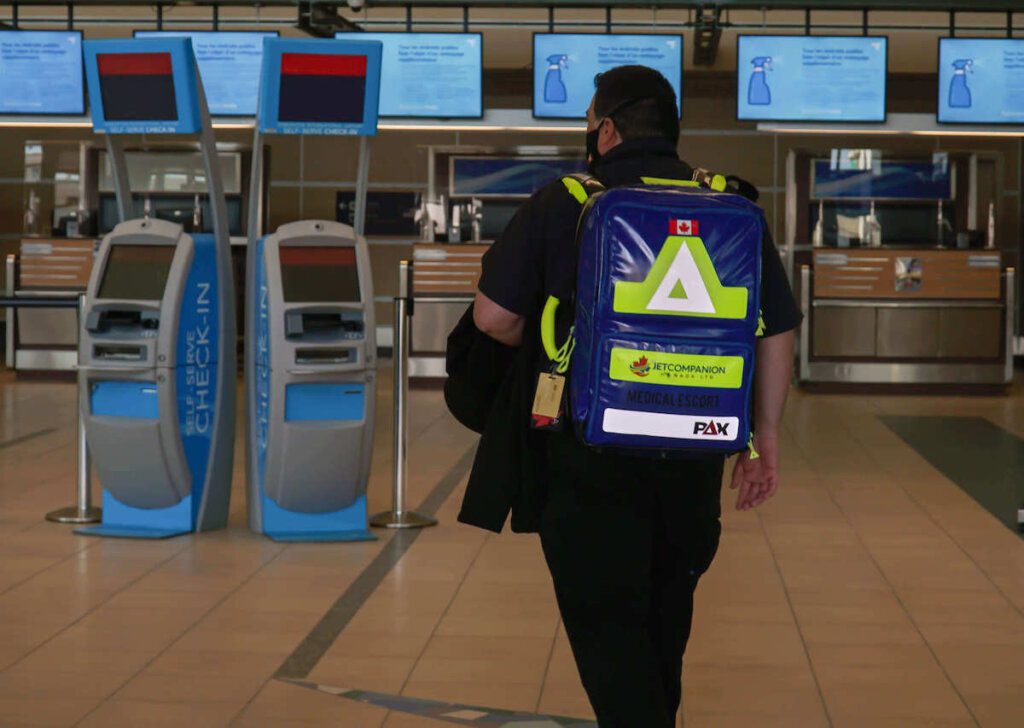Memory Cafe Directory posts and/or links to retailers can be advertising, sponsored, or affiliate links. We may earn a small commission from them. Thank you.
Traveling with Dementia can be an Empowering Success Story Instead of a Disaster
Submitted by Guest Contributor:
Flight Paramedic Rudy de Kort
Tips for Traveling with Dementia Patients
More than ever, generations that would traditionally live together, are now multiple flight hours apart. That includes 50 million people with dementia who live anywhere in the world, sometimes extremely far away from their loved ones. You may ask yourself, “can someone with dementia travel?” The answer is yes! (But with some planning.)
Former Frequent Flyers
As a medical travel companion, I escort travelers with dementia who have generally flown all their life. They are quite comfortable boarding an airplane, but they start losing momentum as the disease process started interfering with some of the critical tasks associated with flying: navigating the airport for example, or understanding safety procedures and meeting social expectations while in public.
Like other activities of similar complexity, the travel experience as a whole can now suddenly lead to confusion and anxiety. It takes just one regrettable incident, for a family to conclude that is neither safe or appropriate to allow mom or dad to travel any longer. Traveling with someone who has dementia can be a challenge.
But it’s a big chunk of life to take away from a former frequent flyer: not going places, not meeting with the people who matter most. It will inevitably lead to social isolation. So in my humble opinion, the decision to stop flying as a consequence of a dementia diagnosis should not be taken too early, if there are other ways to manage the new challenges in the interim.
Airport Hurdles
Traveling with mild to moderate dementia is viable in many cases, in the absence of obvious red flags. Traveling with an elderly parent with dementia can be done, but it’s also not to be taken lightly. Simply booking a flight, and showing up at an airport unprepared for what could potentially go wrong, is the perfect recipe for disaster.
Unfortunately, airlines and airport staff know this all too well. Traveling alone with dementia is difficult. Every year, situations unfold involving confused elderly passengers who should never have been left alone at the airport in the first place.
The busy and noisy airport environment can quickly lead to a sensory overload and stress, with the most feared example being the security checkpoint, where lots of things need to happen in hardly a few minutes. There is no extra time for someone with dementia to understand each step of the process, let alone to respond quickly enough to what is being asked.
Even after security, there are plenty of other opportunities for mistakes to happen:
- Finding the gate
- Boarding
- Getting through COVID19 checkpoints
- Passport control (for international flights)
- Claiming luggage
- And many more!
Now throw in a few unexpected factors like last minute gate changes, a flight cancellation, an accident with incontinence, or a lost bag. That causes getting from point A to point B quickly becomes too much of a challenge!
About Wheelchair Assistance
While still on the ground, part of that problem is typically resolved by booking wheelchair assistance with the airline and having an attendant bring the person with dementia straight to the doors of the right airplane, or even all the way to the assigned seat. The same thing happens in reversed order, after the plane lands. It’s a free service that is offered on a daily basis at every commercial airport and lots of people know this already.
However, it’s good to keep in mind that the wheelchair attendant’s role is to help with mobility challenges only. They can’t help with toileting, a change of clothes or offer behavioral support if a confused passenger becomes agitated and wants to leave.
The same applies to cabin crew onboard the aircraft. Flight attendants can certainly keep an extra eye on a passenger with dementia and they’ll often go above and beyond to make the flight experience an enjoyable one for those who need extra support onboard, but they are not caregivers.
As an example, they’ll help open up food packages on the meal tray, but they can’t actively feed a passenger or give medication. They can wheel an immobile passenger to the lavatory, using an aisle chair, but they can’t go into the lavatory to help with cleaning and changing. For these, and many more reasons it’s a bad idea to rely solely on cabin crew, by sending someone with dementia alone on a long flight.
Flight Attendants
Even if someone with dementia is deemed fit to cross the ocean on a long-haul flight, you can expect some degree of confusion and misunderstood behavior due to time zone crossing, spatial disorientation, and the reduced availability of oxygen in a pressurized cabin.
Situations in which a passenger with dementia gets fixated on getting up and leaving the plane, while the seatbelt sign is switched on are all too common. Just like the restless passenger who wants to search the cabin for a lost object or the one gentleman who kindly attempts to wake up fellow passengers when the cabin lights are dimmed to alert them of a power outage.
Someone on that flight is going to have to get busy to avoid problems, by offering continuous distraction and one-to-one guidance. It won’t be the flight attendants, though. They simply don’t have the time, as they have too many other tasks to complete. Your plan should either include flying-along yourself as a caregiver or hiring a professional travel companion, who is familiar with both dementia and the flight environment.
If you are traveling yourself as a caregiver, I recommend talking to a flight attendant as soon as you board the plane. Discretely make the crew aware that your loved one will need extra time and patience. You can either briefly describe the situation, or handover a little downloadable card that is found on websites that promote dementia-friendly travel.
Don’t assume that the cabin crew already know, because you asked for a wheelchair at check-in and casually mentioned “Alzheimer’s” in the process. An informed crew will happily be on your team when you try to make things work during the flight.
The Toilet Break
A word about lavatories on board commercial aircraft: consider how “easy” is it for you to find the trash bin and the flush-button, use the water tap of the sink, find the folding door and open it, and take care of business in a cramped closet that is likely moving up and down?
Now imagine the confusion and frustration for someone who is coping with cognitive and motoric challenges and needs more space and time to be able to function – instead of less. While onboard lavatories are designed with the input of ergonomists and industrial psychologists, I don’t think that the abilities and limitations of people with dementia are ever considered.
So your extra support is never too much to ask for, and if possible, I suggest a toileting stop shortly before boarding. Also try to book an itinerary with a stopover instead of a long non-stop flight. Don’t get me wrong: I understand the temptation to get the journey done and over with as soon as possible, but in my experience, a scheduled interruption of those long hours in the cabin of an airliner will prove to be a helpful tactic. Use incontinence material as a precautionary measure only, and as a backup plan, not as your first option.

Courtesy Rudy de Kort
Red Flags
Of course, there is a point in the disease process when flying is no longer a good idea. For that reason I can’t stress enough that a family physician or a specialized health care provider, trained in the care for dementia patients, should always be involved in the decision-making on whether a person is considered fit to endure a long distance flight in the first place.
If the answer is inconclusive, the next questions should be:
- Can the potential pitfalls be safely managed by making a plan and including certain care interventions?
- Do you consider the involvement of a professional travel escort to be an option?
Some red flags are unmistakable reasons to discourage any attempt to fly. If the person is unable to follow instructions, or when confusion and expressions of challenging behavior are persistent, severe and disruptive, it’s unlikely that a doctor will sign a “fit to fly” letter, or that an airline will accept the passenger onboard.
On the other hand, a history of psychosis, extreme anxiety, mood swings, restlessness, emotional outbursts or the use of inappropriate language is not necessarily a hard contra-indication. That is, if the behavior has been safely controlled for a while with prescribed medication and focused behavioral support.
I should also mention the most important “physical” red flags like any significant fall risk, or incontinence that can not be easily managed. Any health condition that is unstable and has a reasonable potential to provoke a medical emergency during the journey should also be carefully assessed by a treating physician and re-assessed by a doctor of the airline.
Seven Tips to Keep in Mind
Flying and enjoying the freedom of being able to travel, is not always an option for someone who needs memory care. “Not always” leaves the door wide open for many for whom it is feasible to embark on the journey.
Different types of dementia come with a diverse range of challenges. There is no one-size-fits-all approach. But with the right preparation many people with dementia are not only able to safely travel each year, but they can look back on a positive travel experience, something that they truly enjoyed doing, in a time of their lives when the words “can’t do” and “can’t go” are spoken way too often. I can attest to that. Here a few take-a-ways that can help you plan a much-needed trip for your loved one or a client with dementia:
1Encourage cabin crew and airline staff to speak directly to the passenger with dementia, in short sentences. Offer clear instructions and small chunks of information.
2 Stay in sight for reassurance, especially in high-stress phases of the journey, like the airport security check.
3 Be equipped for successful distraction: pack a photobook, magazines, sunglasses, a headset or earplugs, a favorite blanket maybe.
4 Travel as light as possible but prepare for small emergencies: keep medication, a bib, wet wipes, and a change of clothes in your hand luggage.
5 Be as relaxed and as rested as possible, so that your loved one with dementia can relax at your side.
6 Fatigue and stress equals confusion and irritability. In the context of dementia, providing comfort during a long flight should be one of your priorities.
7 Keep two unwritten rules in mind: 1) It’s going to be a care-intensive flight. 2) Things won’t go 100% as planned.
Rudy de Kort

Rudy de Kort
Rudy de Kort is a flight paramedic, registered nurse, and the founder of Jet Companion, a provider of medical travel companions, based in Canada.
He can be found onboard commercial aircraft anywhere in the world, caring for air travelers who need professional support while they are flying to their destination.
Rudy can be contacted at rudy@jet-companion.com.
Become a Contributor!
 Do you want to be a Memory Cafe Directory contributor? If you have helpful information to share with our community, read about the guidelines, then get in touch to discuss what you have to offer.
Do you want to be a Memory Cafe Directory contributor? If you have helpful information to share with our community, read about the guidelines, then get in touch to discuss what you have to offer.
Thank you.





